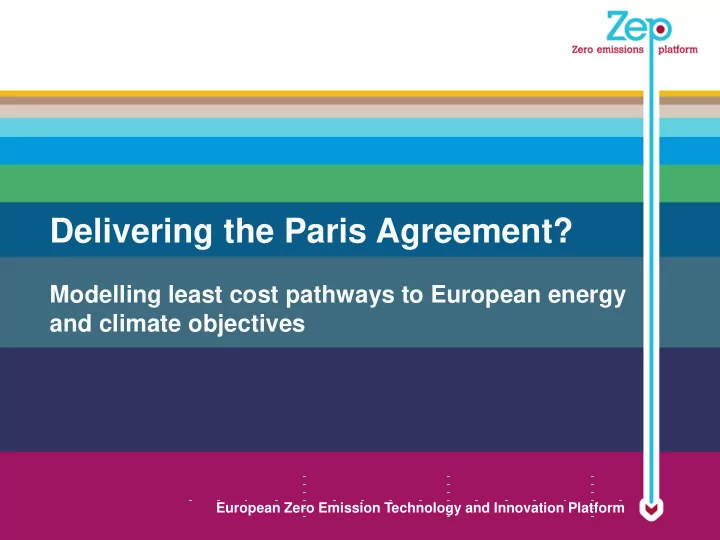

Delivering the Paris Agreement? Modelling least cost pathways to European energy and climate objectives European Zero Emission Technology and Innovation Platform
The ZEP Market Economics energy system model Holistic model including: • Energy Sources • Conversion • Utilisation • Energy Storage • CO 2 Storage Includes for the first time: • Heat • Energy Intensive Industries • Transport • Power 2
Integrated Energy system model • Costs • Consumption • Efficiency • Weather Investment optimizer: • Invests in Heat, Fleet composition Dispatch optimizer: Transport, Industry and • Linear programming Power assets • 8760 hours OPEX & CO 2 • Delivers fleet composition • Minimizes OPEX & CO 2 from 2010 to 2050 • Evaluates CAPEX Lowest Cost Pathway to meet CO 2 target 3
Modelling across 10 countries (and combined) Norway United Kingdom Poland Netherlands Germany France Switzerland Spain Greece Italy 4
Setting the CO 2 emissions target base line • EU 80-95% Reduction ref 1990 • This model from 2010 • This model is energy only • 85% from 2010 to 2050 for Energy is equivalent to 80% ref 1990 • 95% reduction target overall 5
Electricity Generation in 10 countries • Model chooses dispatchable power to better integrate Solar and Wind • With CCS, the backup power does not emit CO 2 • Growth in demand for electricity, transport and heat 5000 5000 Wind 4500 4500 PV Wh) Biomass C C S C HP 4000 4000 Gas C C C C S C HP Generated electricity (T C &L C CS C HP 3500 3500 Biomass C C S Gas C C C C S 3000 3000 C &L C CS Biomass C HP 2500 2500 R ecip C HP 2000 Gas C C C HP 2000 C &L C HP 1500 Biomass 1500 Gas C C 1000 1000 Gas S C C &L 500 500 Nuclear Hydro R iver 0 0 Hydro Lakes 2010 2015 2020 2025 2030 2035 2040 2045 2050 2010 2015 2020 2025 2030 2035 2040 2045 2050 No CCS With CCS 6
Generated Heat in 10 Countries • For many countries, heat is currently the most important CO 2 emitter and, at a system level, heat can help integration of RES because it can be stored cheaply • The model chooses replaces simple Gas, Oil and Coal heating with District Heating, CHP, Heat Pumps, Biomass Solar Thermal and Hydrogen • Centralised Heat and CO 2 capture eliminates almost all emissions from this, the biggest and most-distributed sector • Without CCS simple fuel heaters remain in place to 2050 and beyond 4000 4000 Biomass CCS CHP 3500 3500 Wh) Gas CC CCS CHP District Heating C&L CCS CHP with CCS 3000 3000 Generated heat (T Biomass CHP 2500 2500 Recip CHP Gas CC CHP 2000 2000 C&L CHP Biomass S olar heater 1500 1500 E lectric heater 1000 1000 Heat Pumps Hydrogen heater Simple Fuel Heaters Biomass heater 500 500 Heatpump 0 0 Fuel heater 2010 2015 2020 2025 2030 2035 2040 2045 2050 2010 2015 2020 2025 2030 2035 2040 2045 2050 With CCS No CCS 7
Transport in 10 Countries • Transport makes distributed emissions. Switching to Electricity and Hydrogen can centralise emissions sources for CO 2 capture, if available • Only road transport is considered in this model; 75% conversion limit at 2050 • Early adopters: Norway & Switzerland because low CO 2 in electricity used 600 600 Wh) 500 500 Hydrogen Mechanical energy (T 400 400 Battery Fuel cell vehicles 300 300 Battery vehicles IC Vehicles 200 200 Liquid Fuel 100 100 0 0 2010 2015 2020 2025 2030 2035 2040 2045 2050 2010 2015 2020 2025 2030 2035 2040 2045 2050 No CCS With CCS 8
Cost benefit for emissions reduction in 10 countries 800 • Fuel savings, efficiency improvements and UK, ES , DE, PL, IT, FR , NL, GR , CH, NO technology cost reduction give fairly flat costs curves. No inflation (2010 Euros) Total levelized system costs (b€/y) Without CCS 2050 • District Heating and CHP give cost 600 reductions in early years 2010 With CCS 2030 • 95% emission reduction can only be achieved with CCS 400 Series2 • Without CCS emissions in 2050 are 3-4 ALL times higher ALL_C CS EU reduction target • Saving up to 2050 with CCS = more than 80 - 95% ref. 1990 200 1 Trillion Euro for EU as a whole • Saving 50 Billion Euro per year ongoing across the 10 countries modelled 0 3000 2000 1000 0 • Early investment in CO 2 hubs and Total CO2 emissions (MT CO2 /y) clusters has strong business case 9
Conclusions • 2050 reduction targets can only be achieved with CCS • Without CCS, emissions would be 3-4 times higher in 2050 • Value of CCS to EU of 1 Trillion Euros, up until 2050 • CCS worth 50 Billion Euro per year from 2050 onwards (10 countries) • Future of Energy Intensive Industries in Europe relies on CCS • Infrastructure investment required for reductions before 2030 • Business case for Member States to invest in Hubs/Clusters (now!) • CCS facilitates over-achievement against EU renewables targets • Bioenergy with CCS is key to negative emissions needed for Paris Agreement 10
Recommend
More recommend